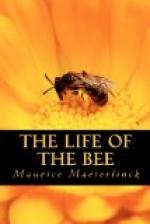Appendix
TO give a complete bibliography of the bee were outside the scope of this book; we shall be satisfied, therefore, merely to indicate the more interesting works:—
1. The Historical Development of Apiarian Science:
(a) The ancient writers: Aristotle, “History of Animals “(Trans. Bart. St. Hilaire); T. Varro, “De Agricultura,” L. III. xvi.; Pliny, “Hist. Nat.,” L. xi.; Columella, “De Re Rustica; “Palladius, “De Re Rustica,” L. I. xxxvii., etc.
(b) The moderns: Swammerdam, “Biblia Naturae,” 1737; Maraldi, “Observations sur les Abeilles,” 1712; Reaumur, “Memoires pour servir a l’Histoire des Insectes,” 1740; Ch. Bonnet, “OEuvres d’Histoire Naturelle,” 1779-1783; A. G. Schirach, “Physikalische Untersuchung der bisher unbekannten aber nachher entdeckten Erzeugung der Bienen-mutter,” 1767; J. Hunter, “On Bees” (Philosophical Transactions, 1732); J. A. Janscha, “Hinterlassene Vollstandige Lehre von der Bienenzucht,” 1773; Francois Huber, “Nouvelles Observations sur les Abeilles,” 1794, etc.
2. Practical Apiculture:
Dzierzon, “Theorie und Praxis des neuen Bienenfreundes; “Langstroth, “The Honeybee “(translated into French by Ch. Dadant: “L’Abeille et la Ruche,” which corrects and completes the original); Georges de Layens and Bonnier, “Cours Complet d’Apiculture; “Frank Cheshire, “Bees and Bee-keeping” (vol. ii.—Practical); Dr. E. Bevan, “The Honey-bee;” T. W. Cowan, “The British Bee-keeper’s Guidebook;” A. Root, “The A B C of Bee-Culture;” Henry Alien, “The Bee-keeper’s Handy-book;” L’Abbe Collin, “Guide du Proprietaire des Abeilles; “Ch. Dadant, “Petit Cours d’Apiculture Pratique; “Ed. Bertrand, “Conduite du Rucher; “Weber, “Manuel pratique d’Apiulture;” Hamet, “Cours Complet d’Api-culture; “De Bauvoys, “Guide de l’Apiculteur;” Pollmann, “Die Biene und ihre Zucht; “Jeker, Kramer, and Theiler, “Der Schweizerische Bienenvater; “S. Simmins, “A Modern Bee Farm;” F. W. Vogel, “Die Honigbiene und die Vermehrung der Bienvolker; “Baron A. Von Berlepsch, “Die Biene und ihre Frucht,” etc.
3. General Monographs:




